Berries and
Currants
When I noticed last week that every time I walked down the
garden a guilty blackbird flew noisily out of the soft fruit I knew
that the redcurrants must be nearly ripe.
Many berries and currants seem to like a cool climate and
slightly acid soil and this means that they generally thrive in Mid
Devon. They don't actually require a lot of work and then
suddenly at this time of year they throw masses of fruit at you
(and the blackbirds).
Blackcurrants are the most obvious plant to
grow. Blackcurrants provide early food for bees and fruit for
us at midsummer. A small plant may take a couple of years to
establish. After that it will require winter pruning.
This merely involves thinning out the older shoots to leave the
young, productive ones. Perhaps take out a quarter of
the whole plant every year and leave well-spaced, outward growing
shoots. ( These prunings can be used to create new plants). Because your blackcurrant
and soft-fruit bed is going to be a long-lasting feature of your
garden you should weed it very thoroughly before planting.
The most annoying 'pest' of my soft fruit is bindweed, which is
very difficult to remove once established amongst other plants.
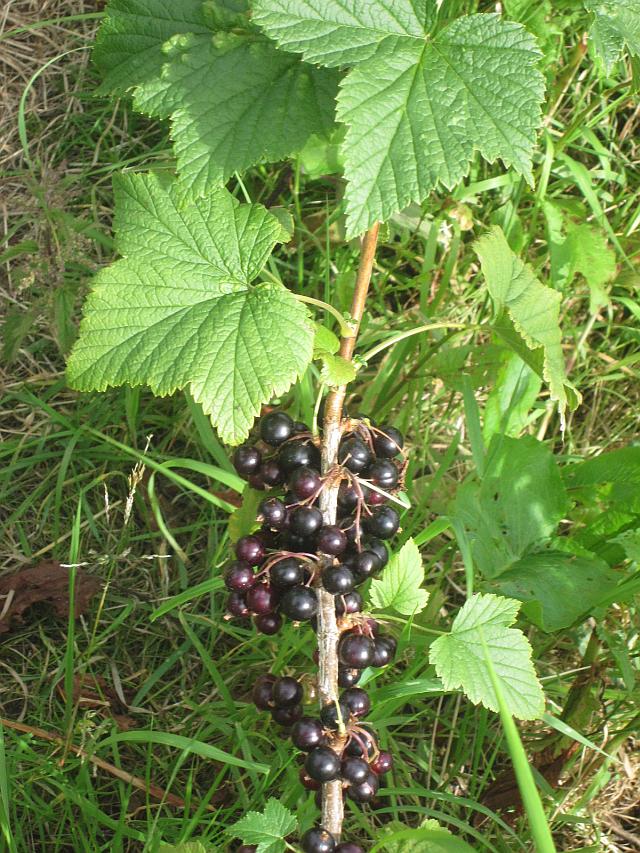
I have at least half a dozen blackcurrant bushes and they are
very productive. This means I get a glut of the fruit.
The fruit and veg grower has to know how to deal with this mass of
produce! Blackcurrants are very versatile.
Yesterday I made a blackcurrant pie using this recipe as guide and fruit that had been
in the freezer for a year. It's really only
blackcurrants and sugar between shortcrust. Home grown
blackcurrants seem to have a wonderfully intense
flavour. There is, of course, the possibility of
jam if your store cupboard is not already over
flowing. If I had children around then I'd
definitely make a fruit leather. This seems very odd till
you try it. You make a fruit puree, maybe add some sugar and
lemon juice and then dry it VERY slowly in a very low oven on some
baking paper. When it's done you can roll it up in the
paper and you can also cut it with scissors. It is a good way
of preserving the fruit with a minimum amount of sugar. Also
if you have a Rayburn or Aga or persistent source of low heat then
you can use that heat efficiently.
Blackcurrants (Ribes nigrum) are packed with nutrients, particularly vitamin C
and the drink 'Ribena' was invented at the Long Ashton
Research Station of the University of Bristol in 1933 and this
cordial was distributed free to children during World War 2.
The leaves of the plant may also have beneficial medicinal qualities.
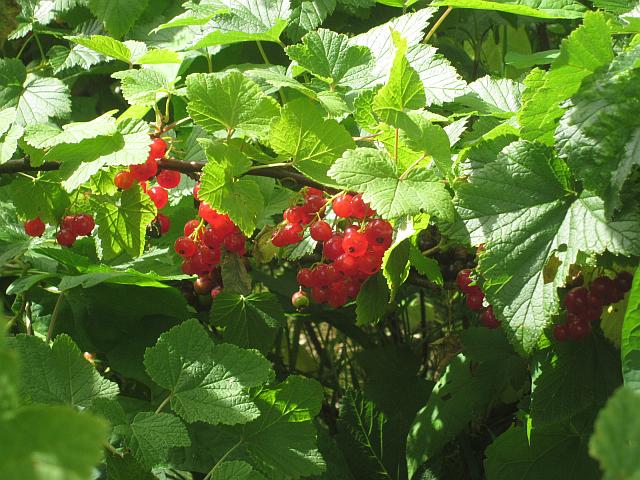
Redcurrants
Redcurrant plants are generally larger than
blackcurrant. Their cultivation is similar. There
are also whitecurrants which are the same species.
There may be some variation between the cultivated varieties of
these species. Redcurrants are generally used in cooking and
with my glut this week I was hoping to make a tart jelly that would
be good accompaniment to fat meat such as pork or lamb.
I went with
this recipe and got a sweet jam. Next time I'll try this recipe. I have a feeling that all these
published recipes contain too much sugar for me.
These currants are very versatile food - for sauces, sorbets or maybe just whizz the glut with ice
and cream.
Gooseberries
Gooseberries generally ripen a bit earlier than
the currants and they also seem to do well in Mid Devon. They
are obviously not a sweet fruit and you are probably either going
to cook them with sugar or else use them in cooking to take
advantage of their tartness. I think gooseberry sauce makes an excellent
alternative to apple sauce with fatty or oily foods. Gooseberry fool is a great summer
dessert.
Gooseberries are cultivated like the currants (and again
prunings can be used to produce new plants) but one obvious
difference is that are spiny. When you prune
gooseberries try to get a gap between the branches so that you can
easily pick them.
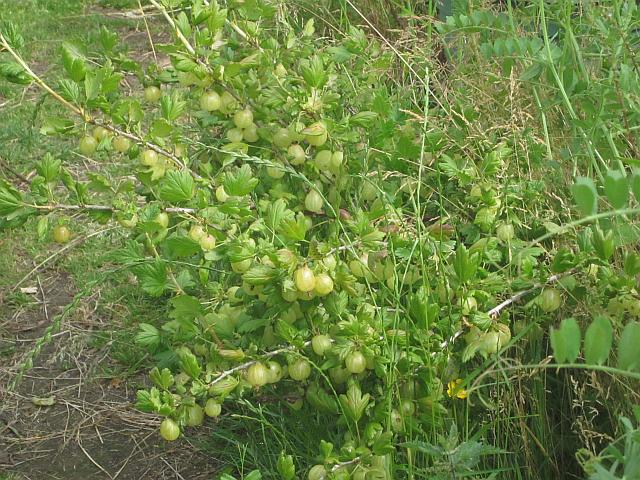
An occasional but significant pest on my gooseberries is the sawfly, which strips all the leaves. The
organic remedy seems to be to cultivate the soil under the bushes
and get the birds (chickens?) to eat the larvae.
How many gooseberries does one household need? I have 3
bushes that are all yielding at the same time. I'll freeze
the glut.
Strawberries and Raspberries
I have to admit that at present I don't 'do' strawberries, except for 2 or 3 plants that
give me some very tasty berries. If you cultivate strawberries properly
then you can get masses of fruit. However their
cultivation seems 'fussy' compared to the other fruits. You
have to manage their runners and weed the strawberry bed. Any
sign of a wet summer will give the slugs a field day in the
strawberry bed and the birds will need to be kept off the ones the
slugs don't get.
Raspberries are a different matter and well
suited to the Devon soils and climate. You might want to
provide sticks or wires to support them but once
planted they need little work. They are planted as woody
stems or 'canes'. The normal midsummer fruiting variety
yields fruit on second year growth. That means that you prune
it back to selected first year stems every autumn. The autumn
yielding varieties (e.g. Autumn Bliss) fruit on first year growth
so you prune them back to ground level every winter. Yellow
varieties are available and I suspect they are not so attractive to
birds. Raspberries will try to spread by suckering but you
can always use the suckers to create new plants.
Often quoted as being a 'super-food', raspberries are very versatile in the kitchen. Summer pudding with clotted cream!
Other berries - and
the hybrids
I'm not going to write much about blackberries here. Maybe
they are the only food that the British really forage
nowadays. There are plenty in the hedges and some always
sneak into my garden. If you plant them then why not try a
thornless variety?
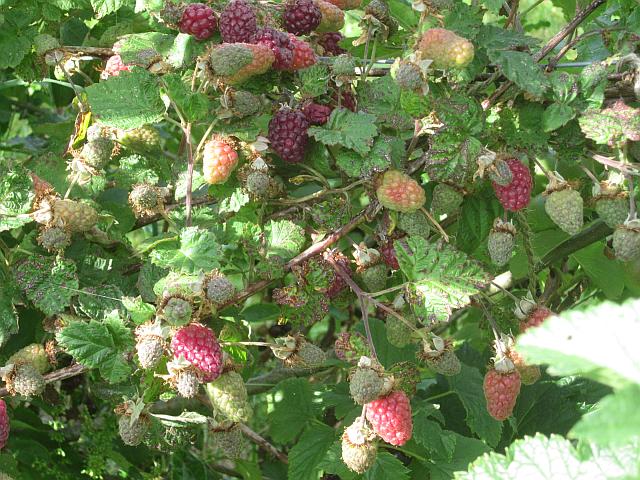
One of my favourite berries is the Tayberry, which is a blackberry/raspberry
cross. The plants ramble like a blackberry and produce large,
sweet fruit. The fruit is so delicate that it has proved
impossible to harvest by machine. As Wikipedia has it
"Tayberries are mainly grown by artisans and backyard growers."
A newcomer to my garden, just establishing itself, is the jostaberry - a blackcurrant/gooseberry
hybrid. This should be interesting! Don't forget that these
plants are easily propagated by cuttings- "Buy One, Get Many
Free".
Blueberries had a spell as a trendy
super-food. This is an American species, not the bilberry.
I haven't tried growing them because they need special
treatment to maintain soil acidity. This makes Exmoor a good place to grow them!
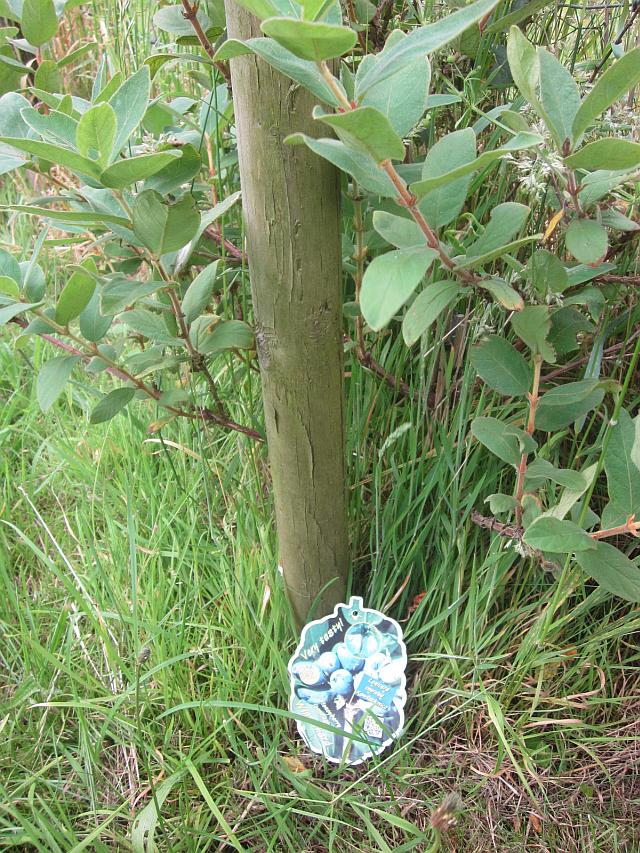
The alternative to the Blueberry is the Honeyberry of the Honeysuckle (Lonicera)
family. A native of Siberia, this is apparently a very hardy
plant. I've planted a couple of them to straggle, honeysuckle
like, along a stock fence. No pests or diseases, judged like a blueberry soaked in honey and with 5
times as much antioxidants - I'm hoping for great things from
this plant. You need more than one plant because they are not
entirely self-fertile. Note that many species of the Lonicera
family produce berries but not many would be judged edible.
The Snowberry, for instance, may look nice but can
be very bad for you.
Suppliers of Soft
Fruit Plants
Good specialist suppliers of fruit bushes are Adam's Apples at Talaton or, via the net, Ashridge Nurseries in Castle Cary. Their
websites will give you a good indication of the available
varieties.
Fruit Hedge
The permaculturalists have a design principle that states "Use Edges and Value the Marginal". It is
the edges or interfaces that often prove most productive. A
thin hedge is all edge and receives sunlight, rain and air from all
sides. My permaculture-inspired fruit hedge consists of
apples, tayberries, blackberries, red and blackcurrants and
gooseberries.
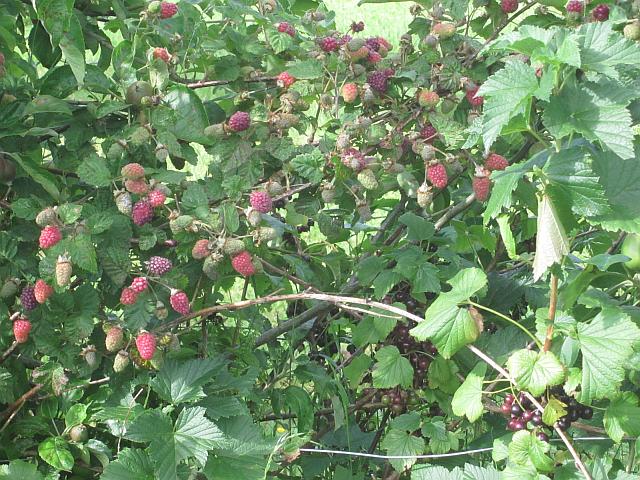
The apples provide the 'skeleton' of the hedge. They are
supposed to be trained espalier style, along wires, to create a
network of fruiting branches from about 4 feet to 8 feet
high. They are about 10 years old now and there are 10
different varieties (cookers and eaters) supplied by Adam's Apples to be productive throughout the
season. Generally my first eating apple is picked in first
half of August.
The tayberries are trained (pruned and tied) in winter to use
the apples as support. Inevitably some blackberries manage to
sneak in.
At a lower level, between the apple trees I've planted
blackcurrants, redcurrants and gooseberries to fill in the
gaps.
When it all works well it is like a wall of fruit with an
embarrassment of nature's riches!
Food Forest - a Permaculture Paradise
The Food Forest concept is a perrmacultural holy
grail. The idea is grow food using as many perennial plants
as possible. These require little input of energy and
maintenance. They also create a diverse environment and
beneficial microclimate for other plants and creatures.
Here's a clip from a site in Canada.
It's a bit precious (see the delight with the single courgette) but
gives the flavour well.
Closer to home is the Agroforestry Research Trust, which has a
demonstration site at Dartington near Totnes. Designer Martin
Crawford is an excellent plantsman and the list of plants for sale is pretty special. Worth
conidering a visit.